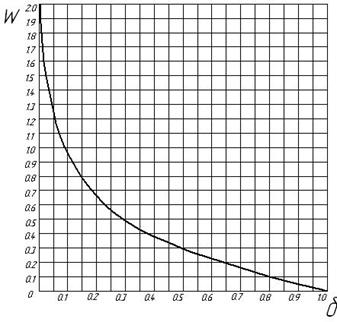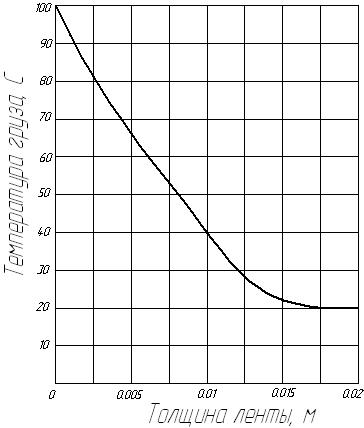| Biography |
| Library |
| Links |
| Report about the search |
| Individual task |
Nazarevich Sergey
Abstract of thesis of master's degree work:
«Research of the thermal state of conveyer ribbon at trasportirovanii hot loads»
Scientific leader: Grudachev Anatoliy
|
|
Nazarevich Sergey Abstract of thesis of master's degree work: «Research of the thermal state of conveyer ribbon at trasportirovanii hot loads» Scientific leader: Grudachev Anatoliy |
Table Of ContentsIntroductionActuality Purpose and tasks of work Scientific novelty 1 Of process of cooling and heating of conveyer ribbon 1.1 Factors influencing are the wear of conveyer ribbon 1.2 Theory of process of cooling and heating of conveyer ribbon 1.3 Mathematical model of difficult heat exchange of hot load with a conveyer ribbon 2. Distributing of temperature of heating on the thickness of conveyer ribbon Conclusions List of references IntroductionPresently a transport is band conveyers is one of the most perspective for the different brunches of industry. Wide application of conveyer transport in coal, mining, metallurgical industry is one of the main directions of technical progress. «At many technological processes in chemical industry, at the plant on production of fertilizers and build materials, in metallurgy, in casting workshops, on koksohimicheskih productions and etc. it is necessary to transport intermediate and ready products, having high temperature. Along with permanent expansion of application domain, by the characteristic tendency of modern development of band conveyers in Ukraine and abroad there is the increase of their productivity, length, power, drive, width and durability of ribbon. All increasing role of band conveyers cause rise of requirements to the wear of knots and aggregates in the number of which one of above all places occupies the wear of conveyer ribbon at the portage of different loads. In this case a ribbon is the most dear and the least lasting element, which efficiency of work of band conveyer depends. Reasons of destructions at influence on the ribbon of different loads, and in particular case hot loads, is an important industrial problem. In this connection, the necessity of research of the thermal state of conveyer ribbon at the portage of hot loads increases.
ActualityA review showed that the analysis of constructions, system of equalizations of heat conductivity, comparative operating tests of heatproof conveyer ribbons, comparison and description of different models of ribbons, is mainly conducted. As for the question of computation of heating of ribbon it is not enough in the process of exploitation of researches, there is only one article. A mathematical model on heating and analysis of the state of ribbon is not present. Of therefore creation of such mathematical model and further researches in this direction are actual.
Purpose and tasks of workPurpose of work development of mathematical model of the thermal state of conveyer ribbon at the portage of hot loads taking into account structural features and modes exploitations of setting, that will allow to find methods and facilities for increases of term of its service.
Scientific noveltyIn master's degree work is offered analytical description of process of heating of ribbon at the portage of hot loads, determination of time of warming up of ribbon and distributing of temperature on a thickness. The planned practical resultIn master's degree work mathematical models are presented which on entry parameters will allow to find time of warming up and to indicate the wear of conveyer ribbons at the portage of hot loads.
1Process of cooling and heating of conveyer ribbon1.1 Factors influencing on the wear of conveyer ribbonExploitation of equipment (1) shows that reliability of work of equipment relies on numerous and various factors which de bane ease can be parted on three groups; structural, production, operating. Structural factors are conditioned influencing of the structural decisions accepted at planning; by application of stuff elements, short of to the terms of environment. Production factors are conditioned by violations of technological processes, muddiness of surrounding air, ambient temperature, by the weak control during exploitation of transport equipment etc. In the process of work of devices their reliability can be lowered at the failure of requirements of terms of environment to observe. Climatic influences, more all the temperature and humidity, affect reliability longevity of any device. Shock viscidity of metallic details of electrical engineering devices goes down at low temperatures: the values of technical parameters of semiconductor elements change; takes place « zalipat load» on a ribbon; rubber collapses. Because of freezing or to thicken of lubricating materials work of switches, handles of management and other elements has difficulty. High temperatures also cause the mechanical and electric damages of elements of transporting devices, accelerating his wear and senescence. Influence of the promoted temperature on reliability of work of transport devices shows up in the most various forms: cracks in conveyer ribbons appear, and, a wear is multiplied, and risen risk of fire. The noticeable influencing is rendered by the promoted temperature to work of mechanical elements of electrical engineering devices. Under influencing of moisture there is very rapid corrosion of metallic details of transport devices, different losses appear, fungus please under act of which the surface of materials is eaten away and mechanical properties of devices get worse appears. Dust, getting in greasing, sits down on parts machineries of transport devices and causes the rapid wear of the ground parts and contamination of mechanical parts. Analysing all said, it is possible to form, factors affecting the wear of conveyer ribbon at the portage of hot loads, the rice 1.1.  Picture 1.1 - Factors of thermal wear Parameters of animation: number of shots = 3, number of cycles = 6.
1.2 Theory of process of cooling and heating of conveyer ribbonFor consideration of process of heating and cooling of conveyer ribbon we will take ribbon Width 2R, the thickness of her counts for little on comparison with long and breadthways, then we adopt them infinitely by large sizes [1-9]. At heating, ribbons are heated from one side from a source with a permanent thermal stream, we find distributing of temperature on the thickness of ribbon at any point to time. At cooling we consider cooling of surface of ribbon to some temperature Ts, we find distributing of temperature on the thickness of ribbon and expense of heat to time at any point. At the decision of the put task we adopt the following assumptions: 1) We equate a ribbon with an unlimited plate; 2) Unlimited plate a width and length of which are very great on comparison with a thickness; 3) The change of temperature takes place in one direction on the thickness of ribbon, in two other directions a temperature is unchanging; 4) Heating takes place by a permanent thermal stream. Scope terms for a conveyer ribbon:  , ,  where:  The common decision of equalization of heat conductivity at scope terms, at set ambient temperatures for platinum of endless length and width width 2S at the symmetric distributing of temperatures in an initial moment, has the following kind:  , , The decision in a general kind for the plate of endless length and width has a kind:  On the method of thermal diagram computation of process of heating is executed as follows: the temperature of surface of good, on which the sizes of thermal streams are determined at the beginning of and at the end of interval, is appointed. On the extreme values of thermal stream find the mean value for the interval of heating as middle logarithm:  On the size of thermal stream of qk the overfall of temperatures is found on the section of good:  The increase of entalpii of good is determined on the mean values of temperatures on the section of body:  Duration of interval is determined on a formule: 
We integrate equalization at times from
 Computation of heating on the method of thin wares with the amendment on massiveness is similar to the conduct of computation on the method of thermal diagram. Duration of heating is determined on a formule:  where: k1 - coefficient of the material loading; S - thickness of the layer(м)warmed up;
With - heat capacity (Dg/(kg*K));
tn - temperature in the initial moment of time (0C); tgr - temperature of hot load (0C);
k2 - coefficient of usredneniya of thermal stream on the section of body; k3 - coefficient of usredneniya of difference of temperatures in a body. Heating ribbons on a thickness on the loaded branch  and its cooling on a thickness on an empty branch 
1.3 Mathematical model of difficult heat exchange of hot load with a conveyer ribbonHeating ribbons on a thickness on the loaded branch  Cooling on a thickness on an empty branch 
For basic data:К1=1, r0=0,02 m, S=1380Dg/(kg*K),  Picture 1.1 - Time of warming up of ribbon at the temperature 130 0С Parameters of animation: number of shots = 7, number of cycles = 6.
2. Distributing of temperature of heating on the thickness of conveyer ribbonThe degree of smoothing of temperatures is a function from the Fure criterion, I.e. Fo=W, and this function which relies on the degree of smoothing of temperatures and from the form of body. Dependence calculated for the bodies of a different form by the resulted decisions, related to the superficial and initial terms, are represented graphicly in [8-12]. Dependence for an unlimited plate and interval proper to the parameters of conveyer ribbon at W from 0 to 2 is shown on the rice 2.1.  Picture 2.1 The Graph for determination of duration of smoothing of temperatures for an unlimited plate Computations are executed for basic data at which the temperature of hot load is equal 100 0С. On dependence of presentment the fig. 2.1 distributing of temperature is got for the thicknesses of conveyer ribbon resulted on the fig. 2.2.  Picture 2.2 - The Graph of distributing of temperature on the thickness of conveyer ribbon
ConclusionIt ensues from the got results, that to the given work the process of heating and cooling of ribbon is explored, a mathematical model is got which allows from to set initial data to define time of warming up of conveyer ribbon by a hot load, Prognosis its wear. To get dependences allow to define distributing of temperature on the thickness of ribbon, that in future will allow to choose the optimal parameters of ribbon. Research of methods and facilities is direction of further researches, for the increase of time of warming up and the same the rise of term of exploitation of conveyer ribbons, which is planned to finish in a December, 2007
List of references1. Вигак В.М., Костенко А.В., Свирида М.И. Оптимизация двухмерных нестационарных температурных режимов при ограничениях на параметры теплового процесса. - Инж. физ. журнал, 1989, т.45, №4 с. 640-645. 2. Алексеев Г.Ф. Обобщение решения линейной задачи о температурном поле неограниченной пластины, нагреваемой неподвижным полосовым источником тепла. - Мат. методы тепломассопереноса, 1982, с. 39-42. 3. Конвективная теплопередача в двухфазном и однофазном потоках. Сб. статей. Под. ред. В.М. Боришанского, М. - Л.: Энергия, 1964 4. Мартишин Е.А., Ананьев Н.В.Исследование теплового состояния конвейерной ленты при транспортировании горячих грузов. - Инж. физ. журнал, 1983, т.45, №2 с. 337. 5. Мартишин Е.А., Ананьев Н.В.Влияние толщины рабочей обкладки и каркаса на тепловое состояние конвейерной ленты при транспортировании горячих грузов. - Каучук и резина, 1985, №12, с. 23-24. Китушин В.Г. Определение характеристик отказов системы при цепочечном развитии аварий. - Изв. АНСССР. Энергетика и транспорт, 1977, №3. с. 20-30. 6. Гинкул С.И., Шелудченко В.И., Кравцов В.В. Вопросы тепло- и массопереноса в материалах, нагрева и охлаждения металла. Учебное пособие - Донецк: РИА ДонГТУ, 2000.- 162 с. 7. Казанцев Е.И. Промышленые печи.Справочное руководство для расчетов и проектирования. 2-е издание, дополненное и переработанное. - М.: Металургия, 1975. -368 с. 8. Тайц Н.Ю. Технология нагрева стали. - М.:Металургиздат, 1961.- 432 с. 9. Осипова В.А. Экспериментальное исследование процессов теплообмена: Учебное пособие для вузов. - 3-е изд., перераб. и доп. - М.: Энергия, 1979. - 320 с. |
|
|